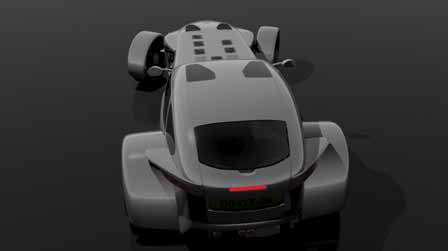2007 Donkervoort D8 GT
For the first time in almost 30 years of Donkervoort Cars company history, the brand is introducing a closed sports car. The D8 GT is delivered with the well-known Audi four cylinder turbo power source with 180, 210 or 270 brake horsepower. Itâs expected that the D8 GT will make its official debut at the Geneva Motor Show in March 2007.
The Donkervoort D8 GT is built on the same chassis as the standard D8 but this has been altered in a number of areas. The front wheel suspension is new and the rear wheel suspension has been modificated for the larger 17 inch wheels. In order to create a smoother ride, the distance between the wheels at the front and rear has been increased by eight and four centimetres respectively. Special shock absorbers have also been developed which have not only a hydraulic automatic height-adjustment but also the option to adjust the stiffness of the absorption in high and low frequencies. The more rigid chassis and the new suspension enable the GT to steer more accurately and precisely. The objective is to create a smoother but also sharper ride. In addition to this, the GT will be faster and safer than the D8.
The underbelly is also sealed over its entire length with a carbon fibre sandwich plate. This enables the diffuser to work more effectively and real downforce is generated. This is a significant step in comparison with the open D8 which is subject to lift at high speed. The carbon fibre underplate also contributes significantly to the rigidity of the chassis. The GT is 30 centimetres longer than an open D8, but the wheelbase is the same. The overhang is 8 cm longer at the front and 22 cm at the rear. This has been done primarily to improve the aerodynamics.
Carbon Fibre
The higher speed potential of the GT is achieved through decreased air resistance and the improved downforce. The improved cW value is due to both the smooth coupé roof and the horizontal winglets left and right in which the rear lights are housed. These winglets alone reduce the air resistance by 5%. Donkervoort uses light materials where possible and the objective is for the GT to be a maximum of 20 kiloâs heavier than a standard D8, which weighs just 630 kilograms. The coupé roof is made from two layers of carbon fibre with an integrated roll-cage in between. The windows are made of polycarbonate, an application developed by General Electric specifically for the GT, including rear windscreen heating. The doors, which are opened upwards and to the front, are also made of carbon fibre. The polycarbonate side windows cannot be wound down but it will be possible to partly open them. Donkervoort has a positive history with closed cars. The car in which the German Donkervoort dealer, Michael Düchting, has already broken the well-known lap record at the Nordschleife circuit was fitted with an experimental hard-top. The D8 GT was developed on the basis of this experience and this means that Donkervoort thinks that there is a good chance to improve on this record once again.
Safer
The increased level of active safety which Donkervoort promises is achieved due to the downforce, the increased rigidity of the chassis and the new wheel suspension. The sum total of this should mean not only higher speed levels through the bend, but also a safer ride. A combination of smoothness and sharpness. Increased levels of passive safety are the result of the integrated roll-cage which offers a higher level of protection and the crash-zones in the nose and tail. The two vertical vents in the rear are exhaust outlets for the warm air generated by the brakes and the differential. They have been built and strengthened so that both vents and the air tunnels behind them form strong crash boxes which provide resistance in the event of a collision from the rear. The underplate also contributes to the crash resistance of the vehicle by making the chassis extremely resistant to distortion.
Donkervoort plans a maximum production of 50 D8 GTâs per year. Prices will be announced in 2007.














